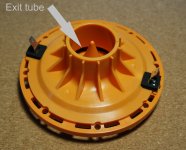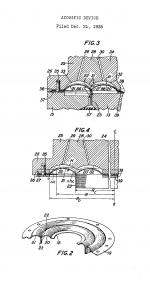Plotted the freq response and impedance with Vituixcad and tried a modified Usher D2 xo.😀 (Still tend go to Xsim when doing fast crude testing)


Oops, the plotter's settings were wrong (used 20Hz instead of 200Hz left scale).
This might be more correctly plotted.

This might be more correctly plotted.

Quite worthless to trace HF driver+horn curves from datasheet no matter is frequency axis decade(s) wrong while exporting FRD/ZMA or not 🙂 For example HF144 with LTH142, traced vs. measured.
P.S. Legis, don't spoil reputation of XSim by screwing up with VituixCAD 😉 XSim is for very experienced designers who know what kind of speaker concept they are copy-pasting. The others need more information in acoustical domain.
P.S. Legis, don't spoil reputation of XSim by screwing up with VituixCAD 😉 XSim is for very experienced designers who know what kind of speaker concept they are copy-pasting. The others need more information in acoustical domain.
Attachments
Kimmosto😀. Quite a bit of difference measured vs. published graphs.
Yep the impedance was also plotted with wrong left freq setting (20hz).🙄 Those xsim pics should be erased in to the ether🙁
Lyckily I got now some other remedy to fill the void caused by the infernal waiting of the faital drivers - new woofers.😉
By the way, I ditched the 18sound adapters and asked the carpenter to make a 77mm long 1,4"-->2" solid wood adapters for the faitals (for the Yuichi horns). This matches the flare rate of the Faital <0,1deg to the same flare rate that the TD-4001 has (built in it). Cannot blame the horn matching after that hopefully🙂
Yep the impedance was also plotted with wrong left freq setting (20hz).🙄 Those xsim pics should be erased in to the ether🙁
Lyckily I got now some other remedy to fill the void caused by the infernal waiting of the faital drivers - new woofers.😉
By the way, I ditched the 18sound adapters and asked the carpenter to make a 77mm long 1,4"-->2" solid wood adapters for the faitals (for the Yuichi horns). This matches the flare rate of the Faital <0,1deg to the same flare rate that the TD-4001 has (built in it). Cannot blame the horn matching after that hopefully🙂
Last edited:
Got a message that my hf1440 had been shipped out😎
Mabat have you connected them to an amplifier yet, with or without a horn?😀
Mabat have you connected them to an amplifier yet, with or without a horn?😀
Quite worthless to trace HF driver+horn curves from datasheet no matter is frequency axis decade(s) wrong while exporting FRD/ZMA or not 🙂 For example HF144 with LTH142, traced vs. measured.
P.S. Legis, don't spoil reputation of XSim by screwing up with VituixCAD 😉 XSim is for very experienced designers who know what kind of speaker concept they are copy-pasting. The others need more information in acoustical domain.
Both measurements seem (inversely) averaged / smoothed. The traced curve shows ripples at the low end and 'smooth' top octave, while it's the other way around in the measured response.
Taking this into account, they are quite similar.
Last edited:
Besides, with a gated MLS measurement the resolution is equal to the gating frequency (usually low). Unless the exact measurement conditions are replicated, the low ends of the curves are not comparable.
Last edited:
Does anyone have an opinion regarding the best 1,4" to 2" adapter for the HF1440 driver to be bolted to Yuichi A-290 horn?
For example, I calculated that in 18Sound adapter the flare rate is 11,5deg conical (37mm thick, 1,4" --> 2").
Now the Yuichi A-290 horn is "optimized" for TD-4001's internal flare rate. What I was able to find was that in TD-4001 the internal flare rate of the driver is closer to 5,5-6deg conical (64,5mm long path and from 1,5" to 2").
Should I be looking for a longer adapter because the Yuichi is optimized for Tad? Or would some faster flare rate be better for the Faital's radial phase plug design? What I understand that in Faital there is no "internal flare rate" and the driver is (acoustically) more like a pancake driver. Or is it... Who the hell knows this stuff😕😀
18sound adapter looks solid and has nice felt pads etc. quality stuff and looks tempting otherwise. Also there is not that much of an alternatives in the market and many do not state the exact lenght of the adapter. Should I tell my carpenter to make a ~55-60mm long wooden adapter😀
You may want to contact member docali. I believe he figured out the math behind the Arai horns.
He (also) thinks the Arai horns are better than the TADs.
Usually pancake drivers don't go well with classic horn types that have slow initial expansion, but this largely depends on the design of the phase plug.
The 'radial design' of the HF1440's exit section does indeed include a conical tube, despite Faital stating "Combined Exit".
Like BMS, B&C, Celestion, JBL etc., FaitalPro more or less adopted Blattner's ancient (WE) patent of a compression driver with an annular diaphragm.
Yes folks, nothing is really new.
Attachments
Last edited:
I believe Faital might state it correctly because the phase plug ends at the mouth of the driver, ie. no flare after the phase plug? But the phase plug is different than "3-5 slit" type. Conventional slit phase plugs also have a flare rate/expansion but I have never seen them taken into account in horn matching, why should we take it into account with Faital... So does this different phase plug design matter from flare rate dilemma POW, I dunno.
If I believe Faital I should go with 77mm long throat adapter which would have the same flare rate than TD-4001's inner flare rate.
If I believe Faital I should go with 77mm long throat adapter which would have the same flare rate than TD-4001's inner flare rate.
I rebuild a fence, a roof of summerhouse and new stairs in the garden... so no, audio has to wait, but I have patience 🙂Mabat have you connected them to an amplifier yet, with or without a horn?😀
As for the exit wavefront, it can be deceiving. I fully realized that with CDX1-1425, which has a tapered exit (a narrowing one), yet it is properly matched by a horn with diverging angle of 20 deg or so at the throat (i.e. the wavefront at the exit is designed to be spherical and diverging) - it's really the phase plug that makes all the difference. I believe with HF1440 there would be a flat wavefront at the very exit of the driver, but who knows.
BTW, I still don't understand what this "pancake drivers don't go well with classic horn types" means.
"BTW, I still don't understand what this "pancake drivers don't go well with classic horn types" means."
Old style driver with buil-in flare is loaded better at low freqs and the transition to "old style" horns that have slow flare at start (expo, hyperbolic etc) is better matched ie. no sudden changes?
Old style driver with buil-in flare is loaded better at low freqs and the transition to "old style" horns that have slow flare at start (expo, hyperbolic etc) is better matched ie. no sudden changes?
What you say is that there shouldn't be a mismatch of wavefronts (or the flare) at the driver-horn interface. I agree but then I still don't understand what's wrong with using a "pancake driver" with about any horn. But maybe I just don't understand what a "pancake driver" is. Is there a definition?
Last edited:
In my understanding a pancake driver is a driver without any inner "matching conical flare" after the phase plug.
Pancake is more versatile as it can be matched using different lenght mouth adaptors to any given flare rate (i think), provided that the throat of the horn is bigger than drivers exit.
Might be something to do if the horn has been matched to specific driver, ie. the designer has taken into account that the driver has "part of the horn" inside it. Without it the low freq loading isn't the same.
Pancake is more versatile as it can be matched using different lenght mouth adaptors to any given flare rate (i think), provided that the throat of the horn is bigger than drivers exit.
Might be something to do if the horn has been matched to specific driver, ie. the designer has taken into account that the driver has "part of the horn" inside it. Without it the low freq loading isn't the same.
Last edited:
Going back to the original sentence -
"Usually pancake drivers don't go well with classic horn types that have slow initial expansion, but this largely depends on the design of the phase plug."
I simply don't understand what is meant by "don't go well" here. What doesn't go well?
Is the HF1440 a pancake driver or not? 🙂
"Usually pancake drivers don't go well with classic horn types that have slow initial expansion, but this largely depends on the design of the phase plug."
I simply don't understand what is meant by "don't go well" here. What doesn't go well?
Is the HF1440 a pancake driver or not? 🙂
HF1440 is a pancake imo. But when any matching throat adapter is added it's not any more pancake systemically speaking (the system as a whole)?🙂
By using a "matching throat adapter" you mean to a horn with different (larger) throat size? I wouldn't do that unless I would be sure that the adapter can be made actually a part of the horn seamlessly. Which will hardly be a case, I think.
- Home
- Loudspeakers
- Multi-Way
- HF1440 New Ring Compression Driver from Faital Pro.


